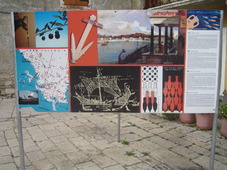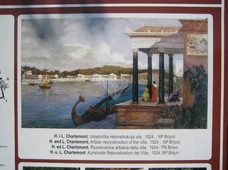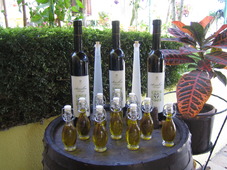to enlarge


or choose the place
from the menu below
 Rome |
 Byzantium |
 Venice |
 Vienna |
 Brioni |
 Smrikve |
 |
 |
It is very interesting the story, documented by Plinio the Elder, that she loved a lot the Istrian wine. This Roman writer wrote: “Julia Augusta (Livia Drusilla) lived to her 85th year of age by merit of the wine Pucinum; and drinking only that wine, whose grape grows in the Hadrian’s Bay, not far from the spring of Timavo, on a rocky hill…”
On the place of current Sovinjak there was a Roman fortress named Pucinum and thanks to Plinio the Elder and Livia Drusilla we know that the Istrian wine was very good at the time.
We also do know that Romans considered Istrian olive oil as the best oil in the whole Empire. They planted at the time several millions of olive trees in the southern part of Istria around Vodnjan, Fazana, Barbariga and also on the Brioni islands.
 Fazana was also home to one of the most important amphorae factories of the Roman Empire
owned by the family Lecanio. The amphorae served as containers for transporting different agricultural products
such as wine, olive oil, grain and salted and marinated fish. At the time, Lecanio was the Consul of the Roman Empire.
Fazana was also home to one of the most important amphorae factories of the Roman Empire
owned by the family Lecanio. The amphorae served as containers for transporting different agricultural products
such as wine, olive oil, grain and salted and marinated fish. At the time, Lecanio was the Consul of the Roman Empire.
Pula also had important fullonica factory. This important fullonica from the 3rd century belonged to Caio Giulio Crisogono and was located in the area of Monumenti (or Molumenti) in Pula’s port. It is known that lavender was used in fullonica’s cleaning process.
 There was another "fullonica”
in Verige Bay on the Brioni islands where one of the most beautiful villas in the whole Empire was located.
There was another "fullonica”
in Verige Bay on the Brioni islands where one of the most beautiful villas in the whole Empire was located.
This villa was placed on 5 hectares of covered area with such a beauty comparable to only two other villas in the Roman Empire: the one on Capri island and the other one in Pompei.
Lavender and some other Mediterranean plants has a very sweet smelling to most of the people and is known that during the Roman period Arena had the wells with the sweet smelling water placed on the top of the square towers.
This water wells, placed on 32 meters high towers, were activating the fountains inside the amphitheatre and this way the Romans were actually spreading a nice smell into Arena.
What has remained in Istria from this old and noble Istrian agricultural tradition?
You will still find a very good Istrian wine, an outstanding Istrian olive oil and also products of the Istrian lavender can be found.
The revitalisation of the Istrian quality olive oil and wine production started at the beginning of the 1990’s while the Istrian lavender projected started few years ago.
 Istrian wines dates back at the end of the 16th century. It is not the wine
from the Roman period but it is malmsey wine imported in Istria by Venetians when Crete was conquered by
Turks.
Istrian wines dates back at the end of the 16th century. It is not the wine
from the Roman period but it is malmsey wine imported in Istria by Venetians when Crete was conquered by
Turks.
As you may know the vineyard is a very delicate plant and if you do not do maintenance of the plants after two years you will loose completely the vineyard.
This is one of the reasons why, after the fall of the Roman Empire, and arrival of the instable times during the Middle Ages this tradition ceased.